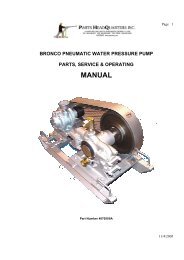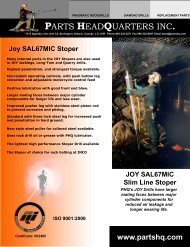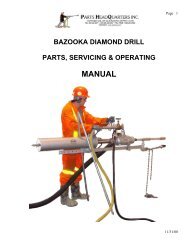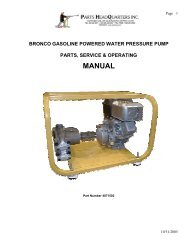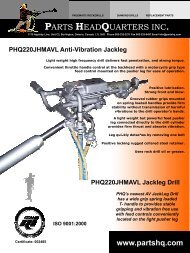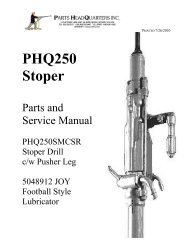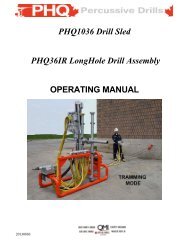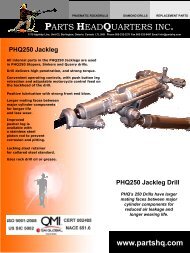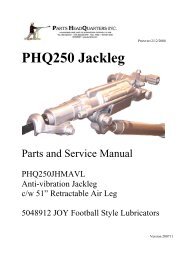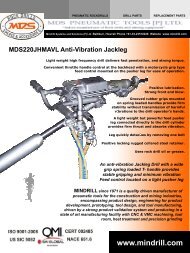jks winkie diamond drill - Parts HeadQuarters Inc
jks winkie diamond drill - Parts HeadQuarters Inc
jks winkie diamond drill - Parts HeadQuarters Inc
- No tags were found...
You also want an ePaper? Increase the reach of your titles
YUMPU automatically turns print PDFs into web optimized ePapers that Google loves.
JKS WINKIE DIAMOND DRILL Page 1OPERATINGMANUALANDPARTS LISTSRevised December 2006Revised October 2008Revised January 2011Revised June 2013
JKS WINKIE DIAMOND DRILL Page 3GW-15WHEN ORDERING PARTS PLEASE GIVE:1. Model of Drill2. Part Name of Part3. Catalogue Reference Number4. Quantity Required5. When ordering parts forengines, pumps, winch, etc.,always include the PARTNAME and the NAMEPLATEREADING of the unit6. Shipping instructionsOrder by Email fromsales@partshq.comSales TermsFreight :Taxes if applicable :FOB Point :Delivery :Payment Terms:Payment By:Currency:Viability of QuoteShipping Specs :INCOTERMS2000 EXW Burlington ON CanadaExtra to destination (can be estimated and included)ExtraBurlington, Ontario, CanadaDelivery date to be estimated at time of quotationTerms to be stated on quotationBank Transfer to Canadian Bank (details to be supplied)Usually Canadian Dollars or United States DollarsPrices are valid for ninety day from date of QuotationDepending on quantities of <strong>drill</strong> material ordered with the <strong>drill</strong>.
JKS WINKIE DIAMOND DRILL Page 4MANUALWINKIE: THE MOST OUTSTANDING BUY IN ITS FIELD:Meet a pint-size powerhouse, <strong>drill</strong>er's <strong>drill</strong>, ready to rewrite your footage costs with itsnine (9) outstanding features.Lower Maintenance - Maintenance costs are reduced over the conventional core <strong>drill</strong>,resulting from minimizing the moving parts, and having only three precision machined analoycastings in the <strong>drill</strong> itself.Lower Moving Costs - Set up and moving costs are very low. Savings may be made withcarrying the Winkie Drill to the site, in lieu of building roads.Lower Labor Costs - Labor cost may be cut by 50% through using only one man to operatethe Winkie. Save by not building roads for the portable carry-in-hand Winkie.Lower Fuel Costs - Fuel consumption under full load is approximately 3 or 4 gallons per<strong>drill</strong>ing shift.Lower Diamond Bit Costs - Dynamic balance in this dri11 means less rod vibration; thus,less <strong>drill</strong> rod and corebarrel wear, and most important, LESS DIAMOND BIT COST.High R.P.M. - High Speed bit rotation plays a very important role in reducing bit cost, inaddition to yielding a greater daily footage. Diamond wear is reduced as speed of rotationapproaches 700 RPM, above 700 RPM, and up to the Winkie Speed of 2000 RPM.Less Handling of Tools - The overhead principle drive on the Winkie allows as great as 3 footruns without re-chucking on the <strong>drill</strong> rod. Compare chucking time of 36 inch strokes for theWinkie, against conventional <strong>drill</strong>s with 24 inch strokes.Less Water Required - Drilling with the minimum water requirements is the best policy withthe Winkie. Experience - No experienced Diamond Drill Operator is required. A minimum ofinstruction is required.Plus these added features: Full 10 H.P. 2 cycle gasoline engine. 6000 RPM. Torque resolving safety clutchBuilt-in water swivel with adjustable packed type water seal.Vacuum carburetion system to allow continued operation of the engine at anyconceivable angle. Circular holding ring (for protection of the unit and completeselection of gripping areas.). Hardened spur gears for quieter, smoother and longeroperation. Water-cooled gear box. Recess mounted bearings designed with a safety factor of "3". Unipress mechanical pull down pressure feed.
DESCRIPTION OF WINKIE DRILLJKS WINKIE DIAMOND DRILL Page 5MANUALThe Winkie <strong>drill</strong> is a lightweight portable core <strong>drill</strong>. The <strong>drill</strong> was designed to recover 1" cores toa depth of 450'. In some formations, cores up to 2 1/8" in diameter can be recovered to lesserdepths. A lightweight water pump is used to circulate water to remove the cuttings and to coolthe bit. Diamond core bits specially designed or selected are used to cut the rock. In somesofter overburdens, drag bits can be used to put the hole down to solid material.APPLICATIONS The principal applications of the Winkie are:1. Exploration - core samples desired for mines or quarries.2. Probing - to find depth to rock for foundation or other testing.3. Highway Sampling - concrete cores recovered for testing pavement.4. Masonry Drilling - cutting holes through reinforced concrete, brick; for conduits, pipes,etc. used by public utilities, industrial plants, refineries, maintenance work, etc.5. Grout Holes - Drilling holes for the purpose of grout injection. After the grouting hasbeen completed, a series of holes can be <strong>drill</strong>ed to produce cores showing theeffectiveness of the grout.6. Marine Blast Hole Drilling - in certain applications, due to its portability and principaloverhead direct drive the <strong>drill</strong> can be operated from an inexpensive boat or raft.7. Underwater DrillingRemember, the Winkie Drill is the smallest and lightest weight patented gear shift <strong>drill</strong> of itstype on the world market.LIMITATIONSThe Winkie <strong>drill</strong> cannot be used to produce cores in gravel, sand or silty clay formations. It isnot designed to compete against jack hammers for production <strong>drill</strong>ing. Its principal applicationis where cores are primary and hole is secondary. However, in some cases, such as <strong>drill</strong>ingholes for parking meters, the hole can be <strong>drill</strong>ed to required diameters. With jack hammers, arough hole by comparison is <strong>drill</strong>ed. As you see the Winkie work, more ideas for its applicationwill be uncovered.COMPONENTS OF THE WINKIE DRILLThe <strong>drill</strong> itself consists of 3 assemblies:(1) Engine(2) Transmission(3) Unipress1. Engine - 10 HP, 2 cycle, air cooled gasoline engine. Easy starting with a nylon cord recoiltype starter. A vacuum carburetor system allows <strong>drill</strong>ing "up" holes or at any angle. The engineis mounted with its drive shaft vertical so that it drives directly into the transmission.
JKS WINKIE DIAMOND DRILL Page 6MANUAL2. Transmission Assembly - The transmission contains the clutch, gear box and water swivel. Theengine shaft, through a splined connection, drives the centrifugal clutch. As the engine speed isincreased past 900 RPM, the clutch shoes are thrown out and engage the clutch drum which rotates theinput shaft to the gear box. If the engine speed should be reduced to lower than 900 RPM, the springs onthe clutch shoe will pull the shoes away from the inner drum surface and, of course, power to the <strong>drill</strong>rods is removed.3. Unipress - The Winkie Unipress enables the operator to exert a steady pressure with a minimum ofexertion. Fatigue of the operator is reduced by 50% or more, contributing to more economical operation.4. Water System - Circulating water through the <strong>drill</strong> rods down to the bit is required to wash outcuttings, cool the bit, and to keep the core from sticking. For this purpose, an engine-pump unitcomplete with hoses and water by-pass system is offered.The pump is a JKS - BRONCO "8" - 7/8 stroke 1-1/2" bore - two piston progressing cavity positivedisplacement 8.2 U.S. GPM at 400 PSI. Since the pump runs constantly with the engine, a pressurevalve relieves pressure on the pump, if for any reason the bit or rods become clogged.A 3/4" x 20' 4-ply pressure hose with fittings and shut-off valve, and a 1" x 15' 3-ply suction hose withfittings, foot valve and strainer are part of the water system unit.Of course, a water supply is necessary. For masonry <strong>drill</strong>ing, city water pressure is convenient. For fieldwork, it may be necessary to use a water tank or drum for the water. If the formation is solid enough, itmay be convenient to recirculate the water from the hole to the tank. In this case a "T" joint on top of thecasing is required to direct the water to the tank.BRIEF HISTORY OF DIAMOND DRILLINGModem Diamond Drilling dates back to the year 1862 when a Swiss, named Jean Rudolphe, gave birthto the idea of mounting <strong>diamond</strong>s in the periphery of a tube to cut a cylindrical core of rock. Even beforethis time, recorded history shows that as far back as 2000 B.C., the ancient Egyptians were using tubular<strong>drill</strong>s to assist in building their pyramids.The first steam-powered <strong>drill</strong> was built in 1862-63. By 1870, steam <strong>drill</strong>s with RPM as high as 360 and5 to 7 horsepower were being used. Through the years, marked improvements have been made inDiamond Drills and their accessories, paralleling the ever-increasing need for rock sampling in hardformations.The introduction of the Winkie Drill was a major step in Diamond Drill development. It offers, for thefirst time, portability with Winkie <strong>drill</strong>ing capacities, presently associated with <strong>drill</strong>s ten times theWinkie's weight. But the Winkie costs only a fraction of other <strong>drill</strong>s.
JKS WINKIE DIAMOND DRILL Page 7MANUALTo get better core recovery in soft formation, it is a known fact in the Diamond Drilling Industrythat larger diameter holes have to be <strong>drill</strong>ed. However, the Winkie Type Drill, with its high RPMand faster penetration using less circulating water, has proven to be the first in various fields toget a larger percentage of core recovery, <strong>drill</strong>ing smaller diameter holes than the conventional<strong>drill</strong>.For instance, on one <strong>drill</strong>ing project using conventional Diamond Drills, the core recovery in thecoal seam was practically nil using double tube core barrels. The Winkie Drill was used on thesame project with a single tube core barrel. It recovered 29-3/4" of coal cores from a 32" seam.The standard Diamond Bit sizes used are the following:**IEW (1-1/2" diameter hole – 7/8 " core)**IAW ( 1 3/4" diameter hole – 1 1/8” core)**JKT-48 (1-7/8" diameter hole - 1 3/8" core)**JKS designed a Thin Wall mining series bits hole as the "W" series to produce a largerdiameter core.The mining series Thin Wall Diamond Bit allows faster penetration and uses less water towash up less sludge. The automatic safety clutch on the Winkie Drill permits the use of thinwall bits to be run with a minimum supply of water without the worry of burning an expensiveDiamond Bit.TECHNICAL INFORMATIONDRILLING PROCEDUREFirst of all, <strong>drill</strong> must be securely anchored.Starting the Drill Hole Starting on Rock Surfaces:A. Use a short core barrel ranging between 1-1/2" to 2, often termed the starting barrel.This barrel is a single or double tube barrel. Drill the starting barrel at least 4" to 6" intothe rock.B. If using a whole stone straight wall bit (a bit without a core spring), dry block. Dryblocking with impregnated bit will significantly reduce bit life.a. Shut off the water supply andb. Run the <strong>drill</strong> at half throttle, at the same time applying pressure to bit.c. The machine will automatically stop when the bit has dry blocked (wedged thecore in the face of the bit with rock dust). With a core spring, the bit may bedrawn off bottom and the core will remain in the barrel. In the event the core maybe left in the hole, a core fisher with springs is attached to the core barrel to fishthe lost core. Do not rotate the core fisher.
Starting with Soil Overburden:JKS WINKIE DIAMOND DRILL Page 8MANUALi. The soil must be stabilized either by casing or <strong>drill</strong>ing mud preceding the initiation ofcore <strong>drill</strong>ing. Casing may be either <strong>drill</strong>ed into the soil or driven until it is well seated intothe rock.ii.Assuming casing has been advanced to rock surface, the casing must be well cleanedout to free it of all foreign matter (mud, gravel etc.) except water. This is accomplishedby a chopping and washing or fishtailing procedure.A tungsten carbide drag bit, adapted directly to the <strong>drill</strong> rods, can be used to put down apilot hole with the WINKIE, and give the operator an estimate on the depth of overburdenand amount of casing required to case the whole to solid formation. After a solid formationwith the drag bit, adapt the <strong>diamond</strong> or tungsten carbide casing shoe to the casing andrepeat the same operation, as when <strong>drill</strong>ing with drag bit but use the casing and rotate itdown the pilot hole made with the drag bit. When this performance is completed, adapt thecore barrel with <strong>diamond</strong> and reaming shell to dri11 rods and start coring.It is also possible to adapt the <strong>diamond</strong> or tungsten carbide casing shoe to the casing androtate the casing into solid formation without a pilot hole. When solid formation isencountered, just leave the casing in the hole as the core barrel will pass through thecasing shoe.If core recovery is required in soft shale formation, a tungsten carbide core bit can be usedas well as a large stone <strong>diamond</strong> bit. It is not possible to take a core in clay, sand or gravel,and never attempt to use a <strong>diamond</strong> bit in the above formations as it will wear and destroyany expensive <strong>diamond</strong> bit.iii.iv.Now, lower the tools to the bottom of the hole in this order:a. Diamond bit and reaming shellb. Core Barrelc. Drill rod or rodsConnect the Winkie to top of the <strong>drill</strong> rods and follow the <strong>drill</strong>ing procedure as outlined insteps A, B and C in the discussion preceeding on starting on rock surfaces.TROUBLE INDICATORSBlocked BitThe <strong>drill</strong> engine automatically slows down, indicating that the core barrel should be withdrawnand the core emptied.Blocked Core BarrelA blocked bit usually shows itself by first a refusal to penetrate and secondly a bumping of thetools as they rotate, commonly called a "kick".
JKS WINKIE DIAMOND DRILL Page 9MANUALNOTE: One of the best methods to gauge the rate of penetration is to mark the <strong>drill</strong> rods with<strong>drill</strong>ers' chalk when the <strong>drill</strong> rod rotates, these rings will disappear below the collar of the holeas the bit penetrates.Always keep very close record of measurements. This is important to your logging procedure.NOTE: If <strong>drill</strong>ing is continued when the core barrel is blocked, it ordinarily results in grinding ofcore, in turn, causing a decrease in core recovery and excessive wear on the <strong>diamond</strong> bit.Continued Blocking of the BitA. Check to see that a free flow of water is reaching the bit. Often times the <strong>drill</strong> rods areobstructed with clay, gravel, etc. Also check your <strong>diamond</strong> bit for inside gauge. It is possiblethe used bit may cut a larger diameter core than the core barrel will admit.B. Possibly an insufficient water pressure is being used. Refer to the pumping chart toestablish volumes for various size <strong>drill</strong> holes. In order to attain these volumes, a positivepressure must be maintained.C. Dented or bent inner tube can cause blocking.Causes of Vibration (Not necessarily in order of importance)1. Lack of rod grease.2. Excessive feed rate or pressure.3. Drilling over or grinding core.4. <strong>Inc</strong>orrect water pressure and volumes.5. Bent rod <strong>drill</strong>s.6. <strong>Inc</strong>orrect size of rods and core barrels in relation to the size of the hole.7. Drill bits too dull.ROTATIONAL SPEED VERSUS LINEAL TRAVELDo not confuse RPM with the actual lineal travel of a <strong>diamond</strong>. A <strong>diamond</strong> on the outsidecutting edge of an EW (1-1/2"dia.) bit at 1000 RPM travels 393 feet per minute. AW (1-3/4"dia.) bit has a peripheral speed of 491 feet per minute. A BW (2-3/8" dia.) bit has a peripheralspeed of 622 feet per minute. A 6-1/2" dia. bit has a peripheral speed of 1636 feet per minute.When a <strong>diamond</strong> bit is not in use, protect it and do not use it as you would a hammer; it isvaluable and will serve you better if used properly. Never drop your rods on the bottom of the<strong>drill</strong> hole; this could severely damage the <strong>diamond</strong> bit. Fill the hole with water before lowering.When changing from old to new bits, use caution in lowering the rods in the hole, and it is agood practice to ream the last two or three inches, just in case the old bit lost some gaugewhich would cause a new bit to get wedged and also damage outside stones. Never wrenchyour <strong>drill</strong> rods down a tight hole. This is bound to damage the outside <strong>diamond</strong>s on the
JKS WINKIE DIAMOND DRILL Page 10MANUALWATER REQUIREMENTS FOR DIAMOND DRILLINGA continuous flow of water is necessary to keep the <strong>diamond</strong>s cool or from polishing: also toremove the cuttings, and to keep the core from sticking in the core barrel.A rising current of 12 inches to 18 inches per second in the hole is usually sufficient.To maintain this latter figure requires about 120 gallons per hour in an EW hole(1-1 /2" dia.);200 gallons in an AW hole (1-7/8"dia.); 430 gallons in a BW hole 2-3/8"dia.) using (EW), (AW)and (BW) <strong>drill</strong> rods.The volume of water required in normal rock <strong>drill</strong>ing ranges from about two gallons per minuteusing XRW rods cutting a 1-1/4" dia. hole, and water pressure required from 80 lbs. to 120 lbs.Had rock formation will consume less water than soft rock formation. Always make certain toflush and clean out the bottom of the <strong>drill</strong> hole before starting to rotate the <strong>drill</strong> rods. This isalways good practice and will increase your daily footage as well as giving a better percentageof core recovery. A constant flow of water through the bit is required at all times whether usinga <strong>diamond</strong> bit, drag bit, a chopping bit or wing type bit.UNIPRESSTo anchor unipress, <strong>drill</strong> hole the same diameter as your split wedge bolt or bolts, approximately5" deep, then tighten the nut to secure split wedge bolt. You are now ready to place yourunipress on top of the same. Then tighten the second nut to secure the base to split wedgebolt or bolts.To <strong>drill</strong> angle holes, use portable protractor with level bubble. Position the protractor on theguide rod. Loosen the two nuts on guide bar hinge bolts and tilt unipress until level bubblecomes to rest at desired angle; tighten both nuts and adjust back stay to maintain properposition.METHODS OF ANCHORING DRAW DOWN CHAIN"Dead Man" InstallationDig a hole adjacent to the boring or casing to a depth where sound soil exists. At this depthundermine the hole. Place a cross bar parallel to ground surface in the undermined hole suchthat when it is lifted up, it butts against sound soil. Attach a chain of sufficient length to this barto tie down the unipress. Now, fill this hole and tamp the soil such that you have constructed a"dead man" anchor.Truck or auto Plate MethodBy using a plate of 10" wide x 36" long x 1/2" thick, a vehicle can be driven on this plate suchthat the weight of the vehicle will "anchor" the unipress. (Which is bolted to the plate).
EYE BOLT OR ANCHOR BOLTJKS WINKIE DIAMOND DRILL Page 11MANUALThe eye bolt is a recoverable split type wedge anchor to secure the base of the <strong>drill</strong> to allowthe operator to exert a pull down force on the cutting tool. Eye bolts come in various sizes. Forexample, for the EW Core Barrel, use 1-1/2" OD eye bolt. Always use same diameter eye boltas core barrel.To secure the eye bolt, <strong>drill</strong> a hole approximately 5" deep, approximately 8" distance from theexploration hole to be <strong>drill</strong>ed; put the eye bolt into the <strong>drill</strong>ed hole then tighten nut on top tosecure the same.SOILS ANCHORThe eyebolt must be replaced by a soils anchor when starting holes in overburden and nooutcropping of rock is available. The soil anchor can be turned into the soil by hand or with awrench, same as an auger. It is complete with chain.WINKIE DRILLING TOOLSMasonry Drilling - For masonry <strong>drill</strong>ing, the <strong>drill</strong> string used is much simpler. This stringconsists of the Winkie, a sub and the masonry bit. The sub is AW box to 1-1/4-7 thread pin, thebox thread on the masonry bit (2" to 6-1/4" dia.) is 1-1/4-7 thread. The core barrel of themasonry bit is an integral part of the bit and is usually 12" long; however, they can bepurchased in 18" or 14" lengths or longer at extra cost."W" SERIES ALUMINUM DRILL RODJKS aluminum rods are manufactured from a high quality seamless aluminum tubing and thecouplings are made from alloy steel. JKS aluminum rods have the following advantagescompared to steel rods; less than half the weight, easier handling, faster lowering and hoisting,increase <strong>drill</strong> capacity, increased production and lower transportation costs. JKS "W" seriesaluminum <strong>drill</strong> rods conform to DCDMA. CDDA and BSI standards.ROD SIZES EW and AW are specified for <strong>diamond</strong> <strong>drill</strong>ing and refer to the outside diameter.EW AWRod O.D. <strong>Inc</strong>hes 1 3/8 1 3/4mm 34.9 44.Coupling I.D. <strong>Inc</strong>hes 7/16 5/8mm 11.1 15.9SQ. Thread per <strong>Inc</strong>h 3 3Five foot (1.52m) aluminum rod and steel coupling Pounds 5.5 7.5Kg. 2.5 3.4
STEEL DRILL RODSJKS WINKIE DIAMOND DRILL Page 12MANUALROD SIZES EW, and AW are specified for <strong>diamond</strong> <strong>drill</strong>ing and refer to the outside diameter.EW AWRod O.D. <strong>Inc</strong>hes 1 3/8 1 3/4mm 34.9 44.Coupling I.D. <strong>Inc</strong>hes 7/16 5/8mm 11.1 15.9SQ. Threads per inch 3 3Five foot steel rod and steel couplingPounds. 17.5 21.7couplingKg. 8.0 9.8DIAMOND BITSMining series - All types of mining series bits are available. See Bit Section.Reaming Shells - The Reaming shell is used between the core barrel and the <strong>diamond</strong> bit tomaintain the gauge of the <strong>drill</strong> hole. See Bit Section.Masonry Bits - Masonry thinwall <strong>diamond</strong> bits are identified by nominal O.D. (inches); sizesup to 14" diameter are available and are complete with 12" long core barrel (or longer onrequest at extra cost). These bits are designed to <strong>drill</strong> through plain or reinforced concrete.They have a very narrow Kerf which minimizes the amount of concrete to be cut. A narrow Kerfbit is also a faster penetrating bit.Bit Salvage - All Surface Set mining series bits and resettable masonry bits may be returnedfor salvage. The customer is given credits for any <strong>diamond</strong>s which are still useable against thepurchase of new bits. In other words, the customer is only charged for those new <strong>diamond</strong>sneeded plus the resetting charge.TUNGSTEN CARBIDE CASING SHOE AND CASTING BITThe casing shoe is attached to the bottom of the casing and is used to <strong>drill</strong> through softoverburden until bedrock is reached. The <strong>diamond</strong> core bit will pass through the casing shoeso that there is no need to pull up the casing until the hole is completed. The tungsten carbidecasing bit will not allow the core bit or reaming shell to pass through. The casing shoe has anarrow Kerf to be used for generally soft overburden. The casing bit has a wider Kerf and willtake greater punishment <strong>drill</strong>ing through boulders and hard pan encountered in the varioustypes of overburden. Tungsten carbide coring bits can only be used in very soft formations.Diamond set casing bits are recommended for hard formations.
JKS WINKIE DIAMOND DRILL Page 13MANUALCROSS CHOPPING BITThe chopping bit is adapted to the <strong>drill</strong> and is used to clean out the inside of the casing beforeusing the <strong>diamond</strong> bit and also to chop out any core left in the hole that cannot be fished outwith the core picker. Any loose material in <strong>drill</strong> holes should be cleaned out before using a<strong>diamond</strong> bit. This method will give the <strong>diamond</strong> bit greater <strong>drill</strong>ing life.DG TUNGSTEN CARBIDE DRAG BITThis bit is adapted to the <strong>drill</strong> rods and will <strong>drill</strong> through any soft formation such as clay andshale when core recovery is not required. It can also be used for probing to determine thedepth of overburden but must be used with water circulating through it at all times.HOISTING EQUIPMENTLOWERING IRONThis is an eccentric clevis with a 5" handle attached. When placed over the <strong>drill</strong> rods, it willhold the rods in position for adding lengths when lowering into the hole.COM-A-LONGS (Pipe Wrenches)These are best explained as open-type simple wrenches and are used to get better leveragewhen pulling <strong>drill</strong> rods out of the hole; also to protect the surface of the <strong>drill</strong> rods. Light weightaluminum pipe wrenches with hardened steel gripping teeth are available.PIPE PIN TO CASING PINTo recirculate and save on water consumption, the adapter is installed to the top of the casing,after bedrock has been reached, and a pipe T is used. EW to 1-1/2" pipe, AW to 2" pipe, andBW to 2-1/2" pipe.ADJUSTABLE PIPE TONGSThe adjustable tongs are used when withdrawing the <strong>drill</strong> rods from the hole. They can belocked in any position, suspending the rods and preventing them from dropping back down thehole.
JKS WINKIE DIAMOND DRILL Page 14MANUALADAPTERSROD BOX TO CASING PINSub used to connect the casing to the <strong>drill</strong> rods.AW ROD BOX TO BW ROD PINRequired when using AW <strong>drill</strong> rods and a BW core barrel.AW BOX TO 1-1/4" - 7 THREAD ADAPTERThis adapter is only required to connect the masonry thin wall bit to the Winkie Drill. AW RODPIN TO EW ROD PIN SUB OR AW ROD PIN TO BW ROD PIN SUBThis sub is used to reduce the size from the Winkie AW box to the smaller <strong>drill</strong> rods and corebarrels such as EW; also to larger <strong>drill</strong> rods. It is attached directly to the Winkie box outputshaft (drive chuck).FISHING TOOLSROD AND COUPLING RECOVERY TAPSUsed when <strong>drill</strong> rod or couplings break in the <strong>drill</strong> hole. It is a tapered and threaded tool that isattached to the <strong>drill</strong> rods and lowered into the hole. Turn the upper string of rods with a wrench,until the tap is secured firmly into the broken lower string of rods, then withdraw the completestring of <strong>drill</strong> rods.CORE LIFTER CASE AND CORE LIFTERRequired on all "I" series and JKT 48 swivel type core barrels. This item must be attached tothe end of the inner core tube to keep the core from falling out of the core barrel whenwithdrawing the rods from the<strong>drill</strong> hole.
JKS WINKIE DIAMOND DRILL Page 15MANUALOPERATING INSTRUCTIONS FOR YOUR WINKIEThe Winkie Diamond Drill is designed to give you the most in <strong>drill</strong> performance and economy.Engine care and operation:The Winkie Drill is powered by a 10 HP, 2 cycle, air cooled, high speed gasoline engine. If thefollowing instructions are carefully observed, you may be assured of dependable and longservice."IMPORTANT "Fuel: Refer to Plate #1619B on fuelWhen operating in extreme cold weather you may add one pint of diesel fuel oil to one gallon ofyour regular Winkie Mix. As above item B explained, this will eliminate the engine stalling dueto the non-detergent oilcongealing in the carburetor.Starting Engine:1. Make sure fuel is at carburetor by using hose pump.2. Move choke lever to choke position (move towards the air filter).3. Open throttle wide.4. Crank the engine by pulling the recoil starter handle. A short, quick pull, allowing nomore than two (2) feet of rope to be exposed assures quicker and easier starting plusgreater starter life. In very cold weather, or if the engine has not been run for a longperiod, two or more pulls may be necessary. After the engine starts, gradually move thechoke lever back until engine has warmed up. When starting a warm engine, choking isnot necessary. Choking a warm engine or excessively choking a cold engine can causeflooding. If this occurs, continue cranking engine until it starts, with the choke pushedopen and the fuel line disconnected.Stopping Engine:Press the “Kill Button” or close the choke to stop the engine.Muffler and Exhaust Ports:The muffler and the exhaust ports should be cleaned every fifty (50) hours when the engine isrunning under continuous full load conditions. Clean every one hundred (100) to one hundred(150) hours when the engine is under light load. Clean exhaust ports if the engine loses power.
JKS WINKIE DIAMOND DRILL Page 16MANUALCleaning Engine:To clean the cylinder exhaust ports, remove muffler and spark plug, then turn the starter pulleyso that the piston is at the bottom of stroke, below the exhaust holes. With any bluntinstrument, scrape the carbon from the three ( 3) cylinder holes so that they are completelyopen and remove the carbon from the surrounding exhaust chamber. Crank the engine severaltimes to blow out the loosened carbon. Replace the spark plug and muffler.Throttle Linkage:For proper engine operation, throttle linkage, and carburetor throttle shaft and spring, must befree of all foreign material. Check each time the engine is used and clean if necessary.Carburetor Adjustments:These three (3) adjustments are on the carburetor:A. High speed at full load adjustment, marked by a stamping on the carburetor housingwith the letter "H".B. Low speed (no load) adjustment, marked by a stamping on the carburetor housing withthe Letter "L".C. Idle speed adjustment, merely is an adjustable set screw to increase, or decrease thedistance the carburetor throttle shaft may travel.High Speed Adjustment:This was previously referred to as the full load adjustment. This has been properly adjustedbefore leaving the factory and should not be tampered with needlessly. When attempting anadjustment, do it while <strong>drill</strong>ing at full throttle. To adjust the engine, the unit must be under load.This adjustment may be made by ear. Rotate the adjustment screw slowly first to the left, thento the right until the engine speeds up and runs at the smoothest tempo. Do not run with screwless than one (1) full turn open. If screw is less than (1) full turn open the proper amount oflubricant cannot enter.For normal operation use one and one half (1-1/2) turns.
JKS WINKIE DIAMOND DRILL Page 17WINKIE DRILL CARE & MAINTENANCECAUTION:MANUALBefore operating the <strong>drill</strong> or starting the engine, fill the gear case with Shell Tellus #69 orequivalent high speed transmission oil.Capacity of the gear case one (1) quart. With temperature of less than 40 degrees F. it may benecessary to thin the oil with any good SAE 30 weight oil. In unusual circumstances when theaforementioned oil is not readily available use SAE 40 weight oil in plus 40 degree F.temperatures, and SAE oil in minus 40 degree F. temperatures. Fill the gear case so that theoil just runs out the filler hole when the <strong>drill</strong> is held in upright position.A. Tighten all nuts and screws after the first eight (8) hours of use.Repeat this tightening of all nuts and screws after each fifty (50) hoursof operation or as needed.SAFETY NOTENever attempt to add or take off <strong>drill</strong> rods while engine is idling. If in doubt about any operationSTOP AND THINK!ENGINE MAINTENANCESpark Plug: (AC 44F, Champion L90C, NGK B5HS)Check plug periodically. Oily or carboned plug causes starting difficulty. Some plugs mayoperate hours and then prove defective requiring replacement.The spark plug should be cleaned, and the points set at .030 inches. If there is any doubt ofthe condition of the plug, it should be replaced with original equipment. (Same type)Air Filter:Replace when necessary.Low Speed Adjustment:This again has been set at the factory and need not be tampered with unless deemedabsolutely necessary. When an adjustment is necessary, run the machine at an idle withoutload, adjusting in the same manner as the High Speed Adjustment. Adjustment should benormally one and quarter (1-1/4) turns for low speed.Idle Speed Adjustment:This adjustment may be governed to suit an individual's preference.
JKS WINKIE DIAMOND DRILL Page 18MANUALNOTE: Two cycle engines, when running under light loads, may appear to miss. This in no wayaffects the operation of the engine.Should Engine Fail to Start:A. Check for fuel in the fuel tank and check to see that the valve is open.B. Check for spark; remove spark plug and, with magneto wire attached, hold the base ofthe plug against the engine, crank engine. A spark should jump across the plug points.If it does not, clean the plug or replaceC. with a new one.D. Check magneto; hold the spark wire 3/16" from engine, spark should jump from theterminal to the engine when cranked. If no spark occurs, test the condenser and coil. Iffaulty, replace.E. Check for flooding. Remove spark plug and if plug is wet or if gap is closed by liquidfuel, the plug should be dried and with shut-off valve closed the engine should becranked until vapor stops coming out of sparkF. plug hole. Re-insert plug and open shut-off valve.G. Check for gasket leaks and for leaks around the crankshaft seal.Should Engine Overheat:Check the flow of air over the cylinder. If restricted by grease or dirt, remove the air shroud andclean cylinder fins. Be sure to use the correct fuel mixture. Use a clean container for mixing oiland fuel. (See Fuel Section - Plate #1619BNEVER USE SYNTHETIC OILShould Engine Knock:Check connecting rod bearings; move flywheel back and forth quickly a few degrees; if rod isworn, play can be felt and a loud click can be heard; if worn, replace. Check piston and pin; ifworn, replace.Should Engine Lack Power:A. Check carburetor adjustments. See instructions preceding.B. Check for carbon. If exhaust port and muffler are restricted by carbon, scrape clean.C. Check compression. Remove spark plug and place compression gauge in cylinderspark plug hole. After cranking the engine several times, the gauge should register 90lbs. or more. If compression is faulty, remove and replace piston rings.D. Check for proper fuel mixture.E. Check cylinder, carburetor, read plate and transfer port gaskets for leaks. Also check forleaks around the crankshaft seals. The governor cover and magneto must be removedfor this check.
JKS WINKIE DIAMOND DRILL Page 19PARTS MANUALFUEL MIX AND ENGINE BREAK-IN1) Factory fuel-oil mix recommendation is 24:1 (1/3 pint oil per gallon gasoline or 4% oil).Factory oil recommendation is BIA-TCW. Oil carries many names, but a "BIA-TCW "label appears on all containers with he proper oil. This oil has passes severe testing byBIA. Under heavy <strong>drill</strong>ing conditions use 20:1 fuel mixture and a 16:1 fuel mixture forbreak in conditions.BIA-TCW or equivalent is recommended (automotive motor oil should not be used).2) Break-in of any new engine is critical and is necessary for reliable operation. Never run anew engine wide open throttle until the break-in has been completed, 45 minutes to (1)hour, of idle and part throttle operation with momentary bursts to wide open throttle andwith at least 2 cooling down periods of 20 minutes to '/2 hour each.3) Be sure proper oil is used and at correct gas-oil ration. If in doubt, for break-in purposes,use a slightly richer gas-oil mix.
JKS WINKIE DIAMOND DRILL Page 20PARTS MANUALMASTER LIST PARTS AND DRAWINGS - WINKIE DRILL ASSEMBLY 5015000ASSEMBLY DESCRIPTION PAGES7820001Drillhead & Transmission Assembly <strong>Parts</strong> ListSchematic PL338A22 23 2424GW10 GW 15 Transmission Complete Detail 37GW10 Water Swivel, Clutch, Shaft Seal Assembly Detail 38GW15 Water Swivel, Clutch, Shaft Seal Assembly Detail 397820000Unipress Complete Assembly <strong>Parts</strong> List25Schematic PL1329A 26W5150265 Head Stop Assembly Detail 27GW10 GW15 Top Plate and Drill Handle Assembly Detail 40GW10 GW15 Motor/Transmission Mount Base Plate Detail 41Unipress Assembly Instruction Detail 42782002 Engine Group Chrysler Two Stroke <strong>Parts</strong> List 28Starter and Fan Housing (Chrysler Engine) 29Ignition (Chrysler Engine) 30Starter and Carburetor (Chrysler Engine) 31 32Power Head 3320
JKS WINKIE DIAMOND DRILL Page 21PARTS MANUALWINKIEDRILL
JKS WINKIE DIAMOND DRILL Page 22PARTS MANUAL7820001 DRILL HEAD & TRANSMISSION ASSEMBLY Drawing M PL1338ADWG QUANTITY PART NUMBER DESCRIPTION1 1 5150128 TRANSMISSION HOUSING2 1 5000172 BEARING3 1 5150023 GASKET4 1 5150015 BEARING AND SEAL RETAINER5 3 5160050 10-24 X '/z SLOT RHMS STE6 1 5040228 OIL SEAL7 1 7830005 HEAT TREATED DRUM8 1 5180046 COPPER WASHER 1" X 1/2" X 5/16"9 1 5160212 ESNA LIGHT HEX NUT R.H.10 1 5160207 7/16 - 2OUNF FLEXLOX LEFT HAND11 1 7830004 STEEL CLUTCH13 1 5150144-M HI/LO SPEED PINION CLUSTER14 1 5054302 RETAINING RING15 1 5000220 BEARING16 1 5150092 GASKET17 1 5222516 5/16" 0 X 1" LG SPRING PIN18 1 5150004 TRANSMISSION COVER BOTTOM19 1 5176307 LOCK NUT20 1 5181307 LOCK WASHER21 1 5000049 BEARING22 1 5150001 BEARING RETAINING GASKET23 1 5150089 BEARING AND SEAL RETAINING24 1 5101416 ¼ 2OUNC X 3/4" LG SHCS25 1 5040229 OIL SEAL26 1 5150123-2 MAIN SEAL SPINDLE AW ROD BOX27 1 5150145 HI & LO SPEED GEAR CLUSTER28 1 5150097 SHIFTING FORK29 1 5000221 BEARING30 1 5054303 SPIROLOX RETAINING RING31 1 5054304 RETAINING RING32 1 5000172 BEARING33 1 5160212 ESNA LIGHT HEX NUT R.H.34 1 5150069 SHIFT LEVER SWIVEL35 1 5150052 INSIDE SHIFT LEVER36 1 5054305 RETAINING RING37 1 5150054 GASKET38 1 5030015 0 RING39 2 5222412 SPRING PIN ¼ X ¾40 1 5150055 SHIFT LEVER COVER
JKS WINKIE DIAMOND DRILL Page 23PARTS MANUAL7820001 DRILL HEAD & TRANSMISSION ASSEMBLY Drawing M PL1338ADWG QUANTITY PART NUMBER DESCRIPTION41 3 5224012 1/4" DIA X ½ " LG DOWEL PIN42 4 5101416 ½ 2OUNC X ¾ " LGSHCS43 1 5200529 SPRING44 1 5160350 10-24 UNC X 3/8” SOC SET SCR CUP45 1 5150064 SHIFT LEVER DETENT46 1 5150065 SHIFT LEVER48 1 5150061 SHIFT LEVER PIN49 1 5150058 SHIFT LEVER YOKE50 1 5150059 SHIFT LEVER SHAFT51 2 5070005 WOODRUFF KEY52 1 5150068 GASKET53 1 5150067 TRANSMISSION FRONT COVER54 4 5101503 1/4-2 OUNC X 7/8" LG HHCS55 1 5200077 3/8" NPT SQ HEAD PIPE PLUG56 6 5180505 5/16 LOCKWASHER57 2 5112303 5/16 - 18 UNC X 2 1/4" LG HHCS58 4 5102603 5/16 - 18 UNC X 1" LG HHCS59 1 5200076 1/4" NPT SQ HEAD PIPE PLUG60 1 5200078 1 /2"STEEL PIPE PLUG61 8 5222520 ROLL PIN 5/16 X 162 2 5150225 LOWER GUIDE BRACKET63 4 5114003 7/16 - 14 UNC X 1 1/2" LG HHCS64 4 5180507 7/16 LOCKWASHER65 4 5150218 BRONZE BUSHING66 8 5150251 CHAIN HOOK67 1 5150217 R H HANDLE BRACKET68 2 5113503 3/8-16 UNC X 2 3/4" LG HHCS69 4 5180506 3/8 LOCKWASHER70 2 5113303 3/8-16 UNC X 2:1/4" LG HHCS71 1 5150220 UPPER CHAIN ADJUSTMENT72 1 5221063 COTTER PIN 3/16 X 1-1/2 LG73 1 5150224 L H HANDLE BRACKET74 1 5150048 RING HANDLE75 2 5112013 5/16-18 UNC X 1 1/2" FLAT HD76 2 5112413 5/16-18 UNC X 2 1/4" FLAT HD78 1 5040230 OIL SEAL SET (2 PER)79 1 5150121 WATERSWIVEL BASE GW 1580 4 5112203 5/16-18 UNC X 2" LG HHCS81 4 5180505 5/16 LOCK WASHER82 1 5150130 PACKING RING GW 15
JKS WINKIE DIAMOND DRILL Page 24PARTS MANUAL7820001 DRILL HEAD & TRANSMISSION ASSEMBLY Drawing M PL1338ADWG QUANTITY PART NUMBER DESCRIPTION83 1 5150122 WATERSWIVEL GLAND GW1584 2 5111203 ¼ 2OUNC X 2” LG HHCS85 1 5180504 ¼ LOCK WASHER86 1 5150049 10” HOSE ASSY87 1 5203448 ½ “ DIAMETR BALL VALVE88 1 8701082 SWIVEL ADAPTER ½ “ TO ¾ “89 1 5070007 WOODRUFF KEYDetail See GW10 Page 38 Detail Clutch See GW10-GW15 Page 38Detail See GW15 Page 39 Detail Clutch See GW10-GW15 Page 39Detail Transmission See Page 37 Detail Motor Transmission Mounts See Page 41
JKS WINKIE DIAMOND DRILL Page 26PARTS MANUALFor Detail Drawingof Top BracketSee Page 40For Detail Drawingof Head Stop AssySee Page 27For Detail Drawingof Base AssemblySee Page 41
JKS WINKIE DIAMOND DRILL Page 27PARTS MANUALWK5150265 WINKIE HEAD STOP ASSEMBLY Drawing PL1527ADWG QUANTITY PART NUMBER DESCRIPTION1 1 5150265-4 BODY2 1 5150265-1 HANDLE3 1 5150265-3 ADJUSTING SCREW4 1 5150265-2 SHOEItem 8 in the General Assembly Drawing of Unipress Assembly Page 26
JKS WINKIE DIAMOND DRILL Page 28PARTS MANUAL7820002 ENGINE GROUP (CHRYSLER TWO STROKE)DWG QUANTITY PART NUMBER DESCRIPTION1 1 5230214 WINKLE ENGINE ASSY/10HP/ELECT. IGN.2 1 175279 MUFFLER GASKET3 1 5151598 WINKIE MUFFLER4 1 5150127 MOTOR ADAP'T'ER GW 155 4 5102603 5/16 18UNC X 1" LG HHCS6 8 5180505 5/16 LOCKWASHER7 4 5102603 5/16 18UNC X 1" LG HHCS8 12 6784549 CLEAR GAS LINE9 1 5201490 3/8 TO 7/8 O.D. CLAMP10 1 5310069 QUICK DISCONNECT MALE13 1 5150028 GAS TANK ASSEMBLY14 4 5170605 5/16 18UNC HEX NUT15 1 5200530 SPRING16 1 5160213 #10 24UNC X 1/2LG RD HD SCREW17 1 5150044 RATCHET PAWL18 3 5180203 3/16 REG FLAT WASHER19 1 5221022 COTTER PIN20 1 5153215 THROTTLE LEVER LINK21 2 5160339 MACH. SCREW 10-24 UNC X 1"22 4 5180403 3/16 LIGHT LOCK WASHER23 1 5153815 THROTTLE HAND LEVER24 1 5150037 THROTTLE RACHET25 2 5160338 MACH. SCREW 10-24 UNC X 3/4"26 1 5150042 THROTTLE LINK PIVOT27 1 5102323 5/16NC X 5/8 SOCHD ST SCREW28 1 5150041 BRASS WASHER29 1 5150034 THROTTLE LEVER SHAFT30 4 5112016 5/16-18UNC X 1 1/2" LG SHCS
JKS WINKIE DIAMOND DRILL Page 29StarterFan HousingREF PART NO. QTY. DESCRIPITON REF PART NO. QTY. DESCRIPTION1* 1096 4 ¼ 20 x ½ PN HD 16* 560456 1 STARTER COP2* 264063 1 COMPLETE STARTER 17 1927 3 10-32x3/8 PN HD3* N/A 3 DOG SPRING 18 559408 1 COIL COVER4* N/A 1 SPRING & KEEPER 19 174648-1 1 CYLINDER COVER5* N/A 1 PULLEY WITH BEARING 20 8026 2 17/64 X ½ X 1/8 WASHER6* K15585 1 ROPE 21 560596 1 FAN HOUSING7* A250132 1 T-HANDLE & INSERT 22 1096 2 ¼ 20 x ½ PN HD8* N/A 3 DOG 23 1439 4 ¼ 20 x 5/8 SLT RD HD9* N/A 1 DOG RETAINER K264063 1 STARTER KIT10* N/A 1 SCREW11* N/A 1 BRAKE SPRING12* 15603-1 1 STARTER SCREEN14 1353 1 7/16 20 FLYWHEEL NUT* INDICATES ITEMS INCLUDED IN THE K264063 STARTER KIT
JKS WINKIE DIAMOND DRILL Page 30IgnitionREF PART NUMBER QUANTITY DESCRIPTION1 1523 2 10-32 x 7/8 PN HD2* 175899 1 GROMMET4* A560475-2 1 COIL ASSY.8 560502 1 COIL BRACKET13 2A560038-1 1 SUPPORT PLATE W/ # 1616 om14 1609 4 ¼ EXT. LOCKWASHER15 1156 4 ¼ 20 x 5/8 SLT FLAT16 2770146-1 1 DRIVE END SEAL17 560097 1 FLYWHEEL18 128498 1 FLYWHEEL KEY19 1457 1 ¼ 20 x 5/8 SLT RD HD* INDICATES ITEMS INCLUDED IN A560475-2 COIL ASSY.
Carburetor (Chrysler Engine)CARBURETOR (Chrysler Engine)DWG QUANTITY PART NUMBER DESCRIPTIONJKS WINKIE DIAMOND DRILL Page 311* 1 018038 GOVERNOR VALVEIA* 1 010404 SEAING RING2 08942-1 SHUTTER SCREW W/L . W.1 013534 COMPLETE CARB (HL329C)5 1 09678 THROTTLE SHAFT CLIP
Carburetor (Chrysler Engine)CARBURETOR (Chrysler Engine)JKS WINKIE DIAMOND DRILL Page 32DWG QUANTITY PART NUMBER DESCRIPTION7 1 01974 RETAINING CLIP SCREW8 1 014288 CHOKE SHAFT AND LEVER9 1 013547 CHOKE SHUTTER10 1 04784 CHOKE FRICTION BALL11 1 08805 CHOKE FRICTION SPRING13* 1 015206 INLET NEEDLE AND SEAT14* 1 014020 INLET CONTROL LEVER15 1 011503 INLET TENSION SPRING16* 1 012345 RETAINING SPRING16A* 1 012884 NOZZLE SCREEN17* 1 02531 WELCH PLUG18 1 013269 INLET CONTROL LEVER SCREW18A* 1 012347 CHANNEL PLUG19 1 013541 THROTTLE SHAFT RETURN SPRING20 1 013406 INLET CONTROL LEVER PIN21 1 013165 THROTTLE SHAFT AND LEVER22 1 011498 IDLE ADJUSTING SCREW23 1 012225 MAIN ADUSTING SCREW24 2 08793 ADJUSTING SCREW SPRING25* 2 011428 ADJUSTING SCREW WASHER26* 2 011401 ADJUSTING SCREW PACKING1 010404 GOVERNOR GASKET27 1 0788 IDLE SPEED REGULATING SCREW SPRING28 1 05095 IDLE SPEED REGULATING SCREW29* 1 012473 DIAPHRAGM GASKET30* 1 012475 DIAPHRAGM32 1 013228 DIAPHRAGM COVER34 6 018031 BODY SCREW35 1 010571 STRAINER COVER GASKET36 1 010527 STRAINER COVER37* 1 010529 STARTER SCREEN38* 1 010530 FUEL PUMP BODY39 1 013335 FUEL DIAPHRAGM40 1 012698 FUEL GASKET41 1 012930 10-24 STOP NUT42 1 7011 THROTTLE SHAFT43 1 A2770589 ARM WITH #42 AND #4545 1 1733 10 24 X 5/8 PN HD* 1 10289 MESH SCREEN1 K10232 CARURETOR REPAIR KIT COMPLETE* INDICATES ITEMS INCLUDED IN K10232 CARBURETOR REPAIR KIT
JKS WINKIE DIAMOND DRILL Page 33PowerHeadREF PART NO. QTY DESCRIPTION1** 175277 1 BEARING CAGE GASKET2 127910-2 1 BALL BEARING3 180018 1 CRANKSHAFT4 31410 2 RETAINING RING5 175017 1 PISTON PIN6 S175016 1 CONK ROD W/# 34 INC.7 175015 1 PISTON8 A175260-1 1 PISTON RING SET9 0247227-1 1 SPARK PIRG (AC R44F)10 1465 8 ¼ 20x1 SOCKF'T HD11 8026 8 17/64 x ½ x 1/8 WASHER12 175518-2 1 CYLINDER HEAD13** 175529062 1 HEAD GASKET13A 175529032 1 HEAD GASKET14 170010 1 CYLINDER W/#19 INC.15** 175223 2 T'PORT COVER GASKET16 560222 1 T'PORT COVER17 1497 2 ¼ 20x7/8 SLT PN HD1439 12 ¼ 20x3/4 SLT PN HD31146 1 DRIVE END SEAL20** 175279 1 EXHAUST GASKET22 1353 1 7/16-20 HEX NUTREF PART NO. QTY DESCRIPTION23 175150 1 CRANKCASE COVER24** 175148 1 C'CASE COVER GASKET25 236157 1 MANIFOLD26 31160-2 2 REED27 31161 2 REED STOP28 1755 4 6 32 x 5/16 RD HD29 1490 2 ¼ 20 HEX NUT30** 175906 1 CARB GASKET31 A31158-1 1 REED PLATE ASSY.With #26, 27, 28.32** 31168 1 MANIFOLD GASKET33 27209-1 2 CARB STUD34 175634 2 CONN ROD SCREW35 A175228 1 CRANKPIN BEERAING38 8060 2 ¼ EXT LOCK WASHER39 9044 1 WOODRUFF KEY40 27209-1 2 SHOULDER STUDSG819-2 1 GASKET KIT** INDICATES ITEMS INCL IN G819-2 GASKET KIT
JKS WINKIE DIAMOND DRILL Page 34OPERATING INSTRUCTIONSFUEL MIXTURENormal operation mixture for Power Bee 2-cycle engines is 1/3 pint (BIA-TCW) two cycle oil with each gallonof gasoline thoroughly mixed in a separate clean container.All brands of gasoline with octane rating of 87 are recommended. Avoid the use of gasoline-alcohol.Strain fuel mixture through a fine meshed screen when filling gasoline tank to remove dirt and water if present.PREPARATION FOR STARTING1. Fill gasoline tank with fuel mixture prepared as instructed above. Wipe up all spilled gasoline.2. Open gasoline shut-off valve.3. Move choke lever to closed position. NOTE: If engine is warm, it may not require choking.4. Open the throttle and crank engine.5. When engine starts, move choke lever to open position.NOTE: A starting point of 1 turn out from closed should be used for both the low and high speed mixture needles.Occasional readjustment may be required but it is not necessary to readjust for starting except for cold weatherstarting when it may be necessary to open the high speed adjusting needle an additional 1 /8 turn.TO STOP ENGINEKill Button Switch will stop the engine by shorting magneto to ground.CARBURETOR ADJUSTMENT1. Turn both adjustment needles clockwise until completely closed.CAUTION: Do not force needle tightly closed as the seat may be damaged.2. Turn both needles counter-clockwise one turn.3. Start engine and allow it to warm up, then, if carburetor setting is too "lean", engine will not run at full speedand will "pop" and may stop. Turn main adjustment needle counter-clockwise an eighth of a turn at a timeuntil the engine runs smoothly.
JKS WINKIE DIAMOND DRILL Page 35If engine runs at full speed without load, but will not maintain full speed under load, turn the mainadjustment needle counter-clockwise 1/8 turn.If carburetor setting is too "rich", engine will not develop full power but will roll and run unevenly under load.Turn main adjustment needle clockwise 1/8 turn at a time until the engine runs smoothly.4. To verify proper idle needle setting, start engine and allow to warm up. If motor surges, and runs at unevenspeed, turn the idle adjustment needle slowly clockwise up to 1/4 turn. If this aggravates rather than correctsthe situation, return to the original setting, then turn the idle adjustment needle slowly counter-clockwise up to1/4 turn. This should cause the engine to "settle down" and run at a constant speed.NOTE: If engine fails to accelerate, open idle screw 1/8 turn.5. If engine runs too fast at idle speed, back out the idle stop screw a little at a time until desired speed isobtained. To increase idling speed, turn in the idle stop screw.MAGNETO IGNITION1. Breaker point gap should be set at .020". Set points with cam follower at highest point of breaker.2. Directional arrow on cam must be UP.3. For magneto inspection or service, contact your nearest authorized dealer.4. If magneto stator plate is loosened or removed from the engine for any reason, be sure it is reinstalled asfollows:A. Place stator plate in position.B. Install hold down screws, but do not tighten.C. Turn stator plate to the mid-range position.D. Tighten screws.E. Reset breaker points to .020" gap.This procedure places the stator plate in position for correct ignition timing.AIR CLEANERUnder ordinary operating conditions, the air cleaner should be cleaned daily. However, under extremely dirtycondition, more frequent cleaning is recommended. To clean the air cleaner, follow equipment manufacturer'srecommendations.IMPORTANT: Dirt that enters the engine through the carburetor is one of the greatest causes of engine wear.Therefore, it is very important that the air cleaner be serviced regularly.
JKS WINKIE DIAMOND DRILL Page 36STARTER SCREENThe screen keeps dirt, etc., from entering the fan housing and clogging the air cooling passages.Because this engine is air-cooled, it is necessary to keep this screen clean at all times to permit the unrestrictedpassage of air into the fan housing.SPARK PLUGCheck and clean spark plugs regularly. A fouled, dirty, or carboned spark plug causes hard starting and poorengine performance.Set spark plug gap at .030".STORING MOTORThe following steps should be taken to prepare your engine for storage.1. Close gasoline shut-off valve.2. Start engine and allow to run until it stops from lack of fuel. This will use up all the fuel in the carburetorand prevent the formation of deposits due to evaporation of fuel.3. Disconnect fuel line and permit all fuel to drain from the gasoline tank. Replace fuel line.4. Remove spark plug and pour cup of motor oil into cylinder. Replace spark plug.5. Crank engine two or three times to distribute oil throughout cylinder. This will coat the cylinder walls withoil and prevent rust from forming during the storage period.TORQUE CHARTFLYWHEELCONNECTING RODSPARK PLUG420 In. Lbs.80-90 In. Lbs.120-180 In. Lbs.GENERAL SCREWS10.24 30 In. Lbs. 1/4-20 70 In. Lbs.10-32 35 In. Lbs. 5116-18 160 In. Lbs114-28 75 In. Lbs.
JKS WINKIE DIAMOND DRILL Page 37From General Assembly Drawing PL1338A Page 24
JKS WINKIE DIAMOND DRILL Page 38From General Assembly Drawing PL1338A Page 24
JKS WINKIE DIAMOND DRILL Page 39From General Assembly Drawing PL1338A Page 24
JKS WINKIE DIAMOND DRILL Page 40From General Assembly Drawing PL1329A Page 26
JKS WINKIE DIAMOND DRILL Page 41From General Assembly Drawing PL1329A Page 26
JKS WINKIE DIAMOND DRILL Page 42From General Assembly Drawing PL1329A Page 26
JKS WINKIE DIAMOND DRILL Page 431. Install guide rod hinges (B) on base (A) withchain adjusting screws (C) to rear.2. Mount <strong>drill</strong> with lower guide bushing (E) overhinge thread (D).3. Pass guide rods (G0 through upper guidebushing (F0 and tighten onto the hinge threads(D).4. Install backstay hinges (H).5. Mount head and shaft assembly (I) on guiderods (G) with shaft to rear. Tighten rodcouplings (J) with long end down.6. Pass chain over shaft through adjusting sleeve(K) far enough to install chain hooks (seedetails). Pull hooks up into square recessagainst adj. sleeve (K). Pull up slack and hangchain on sprocket (L).7. Pass other chain over shaft through squarehole (M) in guide arm, far enough to installchain hooks, pull back into square recess andtake up slack to hand chain over sprocket (N).8. Install handwheel (o) and raise <strong>drill</strong> off rodhinges (B). Turn sleeve (k) up or down toequalize tension on both chains. Secure bypassing cotter pin through hole in sleeve (K)and chain.9. Pass free end of chains up through squarehole in lower guide bushing (E) far enough toinstall chain hooks and lower into squarerecess.10. Remove lower sprocket pins (P) and mountsprocket into chain. Replace pin (P) andtighten chain with adjusting nut (Q).NOTE: Engine Not Shown.
JKS WINKIE DIAMOND DRILL Page 44GENERAL INFORMATIONHOW TO ORDERA formal purchase order on company letterhead mailed or faxed is satisfactory. Email ordersare satisfactory if full company details are provided. Telephone orders should be confirmed inwriting through mail, fax or Email.The purchase order should contain: the full company name, address, phone and fax numbers(for quick reference or clarification) as well as details to contact the authorizing purchasingpersonnel.Please list on the purchase order: quantity, part number, item description, price, shippingaddress and preferred routing for shipmentsWhen ordering complete machines or major assemblies please furnish complete descriptionsof the power unit required, sprocket ratios preferred, swivelhead type, chuck jaws sizes, andother relative information of standard optional equipment preferred.When ordering pumps please furnish complete description of the power unit required, thesprocket size preferred, the bore size, if a transmission, chain or belt drive is preferred and ifgear reduction is required.Mail or fax orders to:WHERE TO SEND THE ORDEREmail orders to:sales@partshq.com
JKS WINKIE DIAMOND DRILL Page 45TERMS AND CONDITIONSTERMSNORTH AMERICA: Net 30 days on approved creditOverdue payment of invoices incur monthly interest charges of 1.5%)EXPORT SALES : Confirmed irrevocable letter of credit drawn on Canadian BankNet 30 days credit terms available through Canadian EDC guaranteesIf purchasing company has an acceptable EDC credit ratingVisa or MasterCard acceptable for payment with referencesPayment in advance of shipment by wire transfer to Canadian BankDELIVERYMost items are available from stock and you will receive a confirmed order acknowledgementspecifying shipment date. Shipments will be routed by the most direct and economical meansof transportation unless otherwise specified and your order should indicate if partial orders areacceptable.RETURN OF GOODSGoods may be returned with the advance express written permission of <strong>Parts</strong> <strong>HeadQuarters</strong><strong>Inc</strong>. Goods returned are subject to 25% restocking charges. Special equipment is notreturnable. Only new <strong>drill</strong>ing material is returnable. No credit will be issued for used <strong>drill</strong>material or tools. <strong>Parts</strong> <strong>HeadQuarters</strong> <strong>Inc</strong>. retains the right to inspect and reject any materialreturned for credit and to deny credit for any goods judged not to be suitable for resale.GENERAL INFORMATIONPrices and specifications listed are subject to change at any time without notice.Quotations for products are dated and valid for no more than 60 days from the date shown.All prices are F.O.B. <strong>Parts</strong> <strong>HeadQuarters</strong> <strong>Inc</strong> warehouse, Burlington, Ontario, Canada, L7L5H9.Federal and Provincial taxes where applicable are extra and charged on PHQ invoices.The cost of exporting documents and insurance may be added and shown on PHQ invoices.Prepaid freight and handling charges may be added and shown on PHQ invoices
JKS WINKIE DIAMOND DRILL Page 46PHQ began twenty eight years ago to supplypneumatic underground mining equipment,replacement parts and mining hardware.PHQ grew into the manufacturing of completepercussion <strong>drill</strong>s, <strong>drill</strong> feeds, <strong>drill</strong> centralizers, remotecontrol panels, mufflers, <strong>drill</strong> jumbos, <strong>diamond</strong> <strong>drill</strong>s,high pressure pumps, <strong>diamond</strong> <strong>drill</strong> bits, rods,corebarrels, and accessories. .PHQ cooperates in active research to findimprovements for pneumatic <strong>drill</strong> equipment. We havesuccessfully developed a patented anti-vibrationdamping handle for pneumatic Jackleg <strong>drill</strong>s workingwith CANMET LLC the University of Sherbrooke and aconsortium of six major Mining Groups in QuebecCanada.PHQ continually strives toward excellencePHQ has maintained an ISO rated quality systemsince1996. PHQ up-graded our in-house qualitysystem in 2009 from ISO9001:2000 to ISO9001:2008and have passed subsequent audits of the up gradedsystem with no faults whatsoever every year since.Annual quality audits are conducted by QMI SAI GLOBALPHQ adopted the picture of a miner running apneumatic hand held Jackleg <strong>drill</strong> as the main symbolof our company. The Jackleg miner is an integral partof the Logo that we proudly display on all PHQliterature. It signifies our commitment to producingsuperior pneumatic <strong>drill</strong>ing equipment for the miningindustry.



